These B2B marketing statistics will support any marketer guide their strategy towards the goals that matter most to them. Whether you’re looking to drive more leads, increase sales or shorten the sales cycle, we have data that will support your business growth and strategy.
If you’re looking for B2B marketing statistics, then you’ve come to the right place. We’ve been conducting original research among sales and marketing professionals and can now present you with 93+ marketing statistics you can use to up your game.
The world of B2B marketing is never still. That’s why it’s so important to keep up to date with the latest developments for your industry.
How do you do that?
By keeping up to date with current B2B marketing statistics and trends. No matter what B2B industry you work in, or what channel you focus on, we have collected a wide range of statistics that will help you better connect with your audience, convert them and track your impact.
To help, we’ve categorised statistics into relevant groups.
Keep reading to learn:
So, let’s dive straight in.
Lead generation is the bread and butter of B2B businesses. So, we asked marketers for their take on key lead generation problems, processes and more.
For many marketers, they have to rely on driving leads as opposed to direct sales. It could be a high-value product or a product that relies on a lot of interaction with a sales rep before purchasing.
Regardless, lead generation as a goal is key to driving sales. The important thing to remember, is that leads don’t guarantee sales.
In fact, we asked them what channel they thought generated the most leads. Here’s what they said:
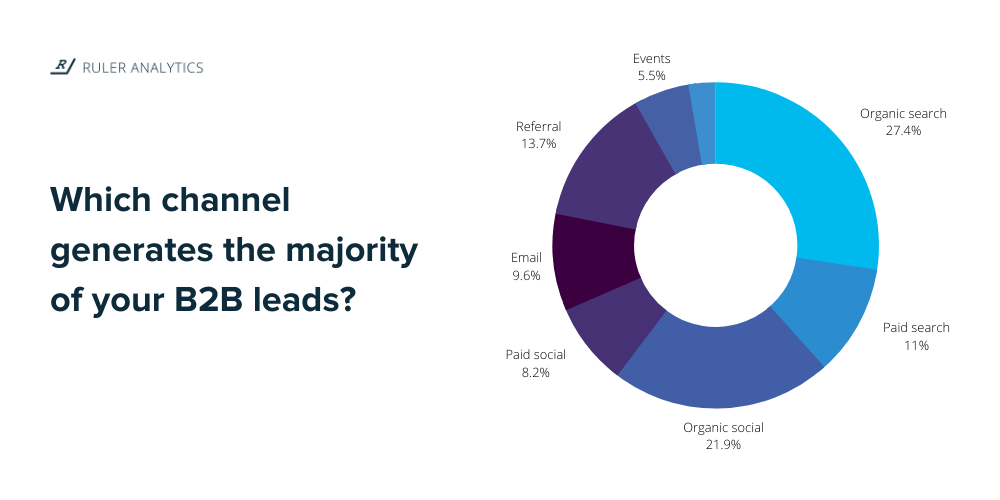
A CRM is a great way to manage and track your leads. Finding the right lead management tool can help you collate your sales and marketing data to better align your teams.
Related: Best CRM Integrations you need to try
While nearly 70% of marketers exclusively store their lead data in a CRM, less than 10% don’t hold lead data at all. With lead data in place, you’re going to struggle to keep track of all of your inbound leads and their data.
A CRM isn’t for everyone. Some marketers opt instead for a Google Sheet or Excel spreadsheet to manage their inbound leads and data.
And while this is a great system, when done well, it can quickly become unmanageable.
For those who need it, we wrote a guide to tracking leads in Google Sheets.
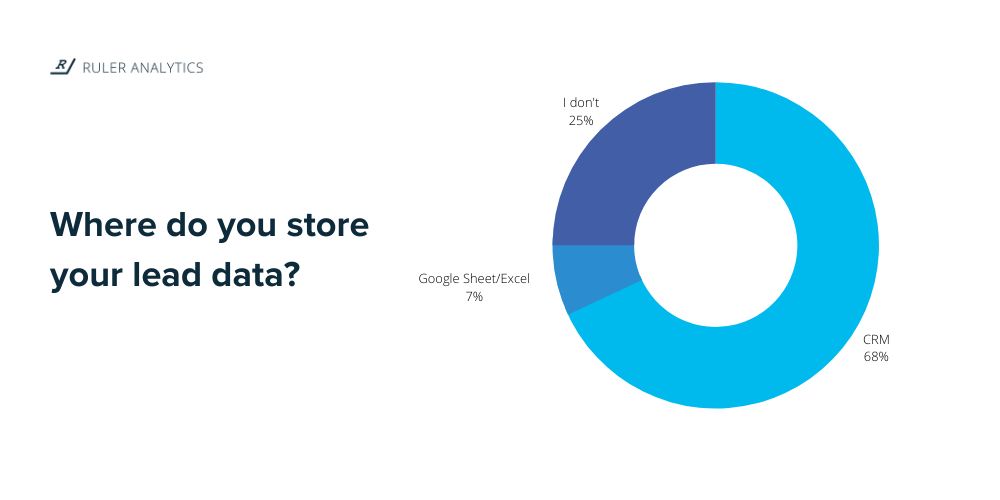
The purpose of attribution modelling is to gain a better understanding of how different channels contribute to your ROI. With the insights below, you can start building better attribution reports for your company and get the credit you truly deserve.
Less than half of marketers currently use an attribution tool of some description. Those using the Google Analytics attribution model are counted as using a tool, though this tool only goes so far as to fully explain the impact of your marketing.
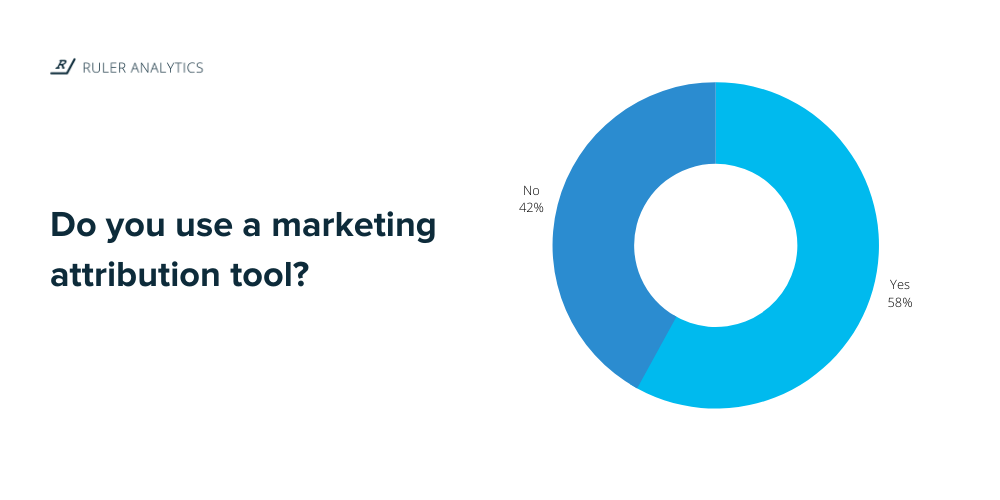
Single-touch marketing attribution models were the go-to for marketers to attribute revenue. But, as the customer journey grows and becomes more complicated, single-touch has become less effective and accurate.
As such, marketers are moving to multi-touch attribution models to better understand and credit their marketing touchpoints.
Last-touch attribution is a pretty straightforward model choice for businesses looking to see which touchpoints work best at converting a lead into a sale.
On its own, however, your view is incredibly limited. You won’t be able to see how your touchpoints are working together to drive users down the funnel. And, you can’t see which channels or campaigns are starting your customer journeys.
Sales and marketing alignment, or smarketing, is a great way to achieve marketing attribution. When sales and marketing unite as one, both teams share the same goals and can focus on driving the right type of leads that convert at a much lower cost.
Read more marketing attribution statistics here.
Ok, so deciding which marketing channel to use is one thing. But which channels do you specifically struggle to track?
We asked 200 marketers exactly that. Here’s what they said:
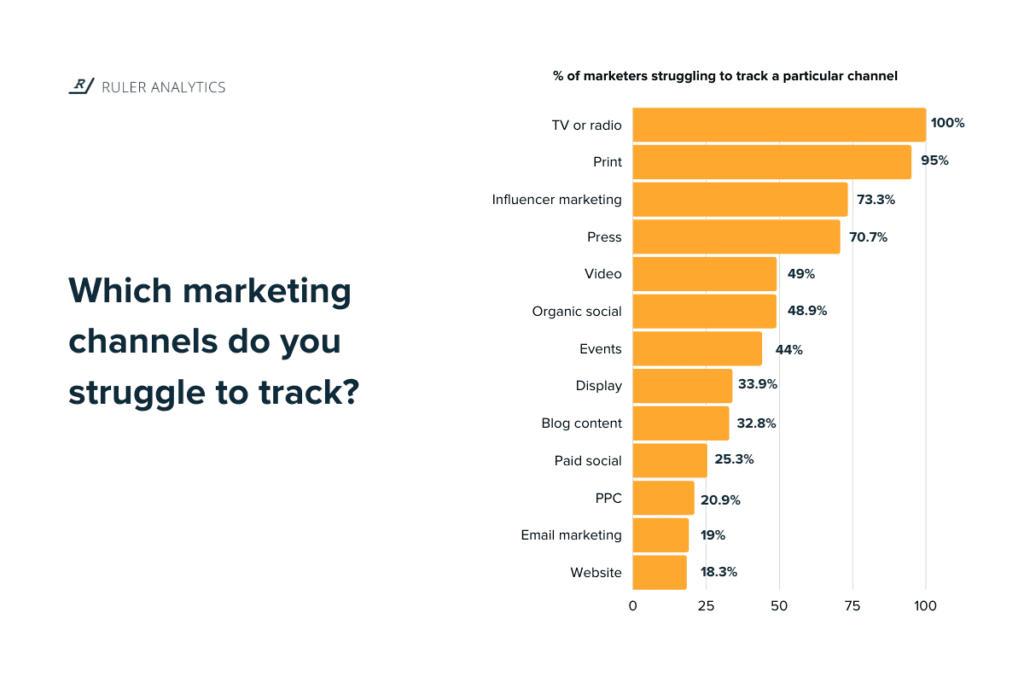
But which conversions are they specifically struggling with? Usually, on a website, there are 3 main ways to convert; a form, a phone number or a live chat box.
We found that:
This is a huge number of marketers using and tracking form submissions as a conversion point.
While you might be able to track the lead volume of form submissions i.e. how many people filled in your form in a given time, you’re missing data.
How do you track how many people filled in a form from your PPC campaign? Or, how many people who filled in a form went on to close into a sale?
Related: How to track form submissions in Google Analytics
While over 80% of marketers use forms on their website, 36% of them struggle to effectively track them.
While they might be able to track the sheer number of form fills, they likely struggle to link leads to full customer journeys or revenue.
Meanwhile, half of all marketers surveyed use calls on their websites to drive conversions. This is a huge number of people relying on offline conversions to drive new leads.
More marketers using phone numbers on their websites struggle than those using forms. And it’s not surprising. Offline conversions are much more difficult to track.
Related: Complete guide to phone call tracking
Live chat is a fantastic tool that’s really grown in popularity in the last few years. Originally seen as a tool mainly for customer service, that’s been thrown on its head recently as businesses now use it for lead generation too.
You guessed it, marketers struggle to track this conversion type too. But tracking live chat conversations doesn’t need to be difficult. While you can track basic metrics in your live chat tool, it’s also possible to link your conversations to your conversions and sales.
💡 Pro Tip
Learn how you can effectively track live chat conversations as part of the full customer journey with our guide to live chat tracking.
A small number of marketers use events to drive new leads. This number may have altered compared to previous years as a result of COVID. It’s still worth noting that marketers continue to use offline marketing tactics like this to generate new business.
When you think about the processes in place when marketers attend events, of course, they struggle to track them. Interested parties at events are difficult to convert, and they might engage with you via further offline channels in the future, making any future sale hard to attribute.
Many B2B marketers face the same challenges in their day to day roles. We explored these key challenges to compile a list.
Related: Read our full blog on marketing challenges
Generating leads is difficult for marketers for many reasons.
There are issues with lead tracking for starters. When leads are converting via form, call, or live chat, how do you ensure you’re accurately tracking each conversion point? Without this tracking in place, you’re going to struggle to link your high-quality leads back to your marketing initiatives. And without that, you’ll never be able to truly optimise your marketing.
Our guide to lead generation and tracking will help you get more of what matters to drive your bottom line.
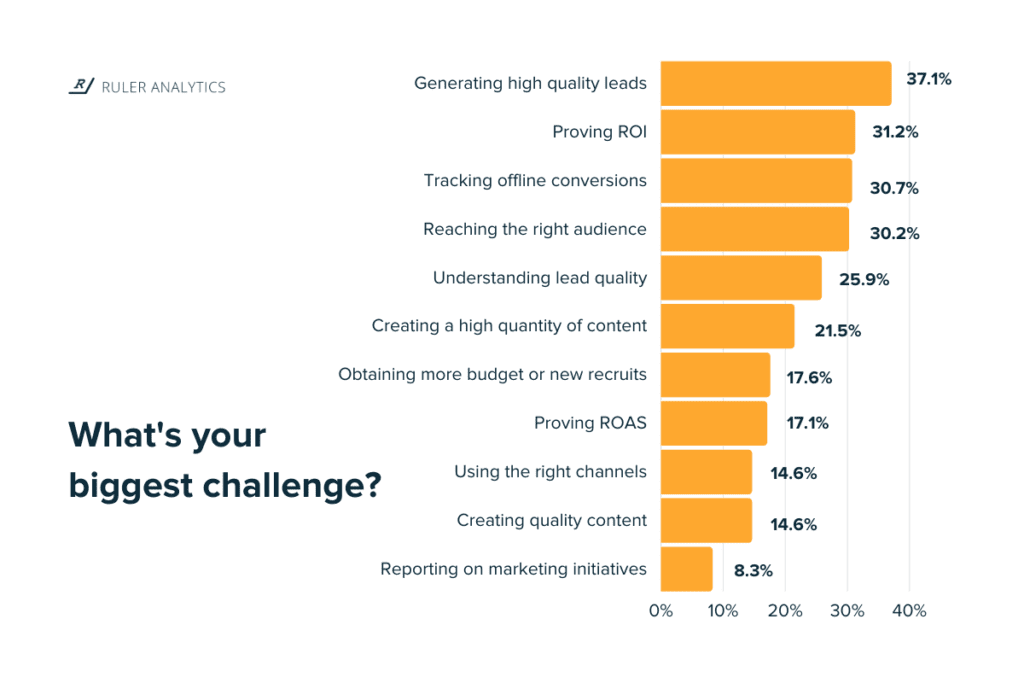
Proving ROI is tricky for most marketers, let’s be realistic.
When there are issues tracking your lead conversions, that’s going to result i inconsistencies when measuring the impact of your marketing.
Thus, your return on investment is not going to be accurate.
Related: How to measure digital marketing ROI
Offline conversions are things like phone calls, store visits or emails. And they’re not easy to track.
Your sales and marketing teams need to align in order to effectively track these conversion points. Without the right tools and processes in place, marketers will continue to struggle to report on these conversion types.
💡 Pro Tip
Offline conversion tracking is kind of our forté. So, we wrote a guide on it. Download our eBook on offline conversion tracking to see how you can connect offline sales back to online leads.
With more and more channels available to use, getting the right message on the right platform to the right person can be a challenge for marketers.
Reaching the right people is basically getting your content in front of people who will convert into high-quality leads.
Improving the visibility of your lead value will result in a much more efficient marketing machine.
Related: How to track the value of your leads
Marketers are under pressure to be on every channel. And with each channel comes different content types or formats. As a result, marketers end up swamped creating or repurposing content for every channel.
Remember, with the right tools in place you can see which channels are bringing the most value and double down on it.
Marketing budget is a beast of its own. And many marketers struggle to justify and obtain more or new budget.
Perhaps you find a particular PPC campaign is doing well and want to add more budget. Or, your organic Instagram content is taking off so you want to maximise it further with paid spend. Presenting marketing as an investment to the senior team can be tricky.
Read tips and tricks from marketers for creating a marketing budget and asking for more investment.
Return on ad spend is a must for any paid advertisers. Using a ROAS calculator, once your data is aligned, can help you better understand the impact of your ad spend.
Quality content will mean different things to different people. And remember, the first step is to ensure that you’re present on the right channels.
Understanding your digital marketing ROI can help you learn what’s working, giving you the time and resource to create more, and better content.
Related: Content that converts: A complete guide
Are you using paid? Social media? How do you know you’re on the right channels?
One way is to check out the competition. Luckily, we did the hard work for you. We analysed millions of datapoints to find the best conversion rates industry and by marketing source.
Most marketers dread monthly reports. We asked 200 marketers for their main thoughts and challenges when it comes to marketing attribution and reporting. Download it to find the main insights.
Every month marketers log into apps like Google Analytics to start compiling data and creating their reports. But how do marketers feel about their reporting and metrics?
40% of marketers aren’t confident they can prove their return on investment. And this isn’t surprising. When B2B marketers have to deal with long sales cycles, offline conversions and more, the result is displaced data.
This can be hard to collate without an attribution tool, so marketers end up going without!
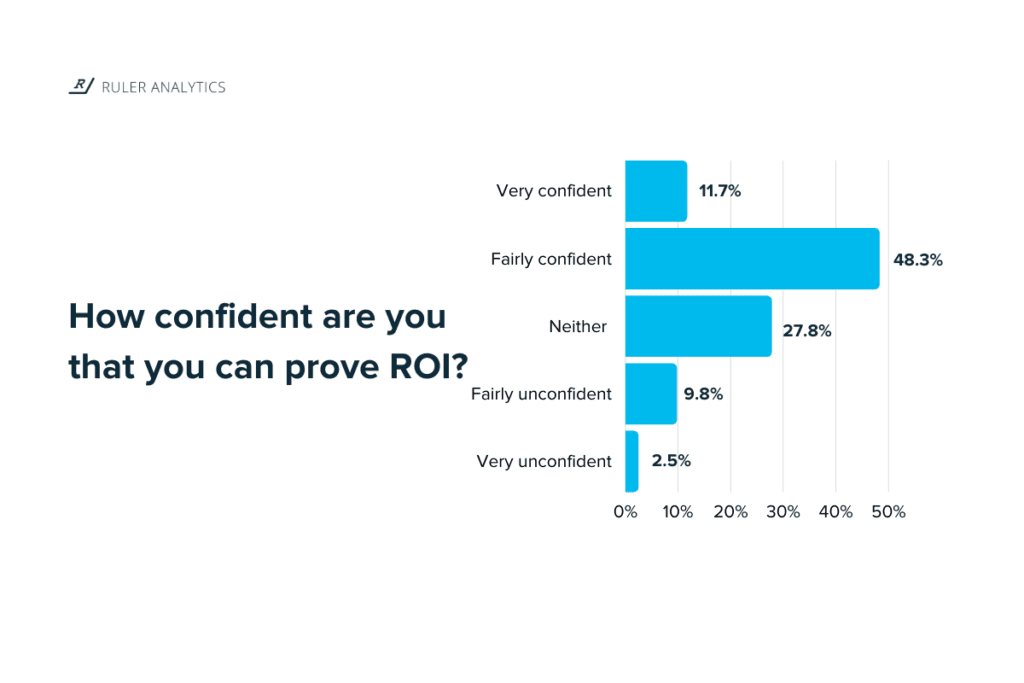
We found that generally, marketers feel positive about their marketing reports. But are they barely scratching the surface?
Remember, actionable metrics are very different from vanity ones. They’re much more difficult to track but it’s worth it in the long-run.
While the majority of marketers are confident, do they have solid proof? Data-driven marketing is key in 2022.
You need to be able to prove to other teams and management that you’re directly influencing inbound sales. This could be through lead or demand generation.
Which KPIs do you track? Picking which ones you need to monitor can be tricky. And it’s clear that marketers aren’t confident in their KPIs.
Which makes us question how they can be confident in their reporting? Ideally, your marketing reports will support your KPIs. The two working together allow you to scale your business.
So now we know more about marketers’ sentiments to reporting and metrics, which ones do they use to measure their outputs?
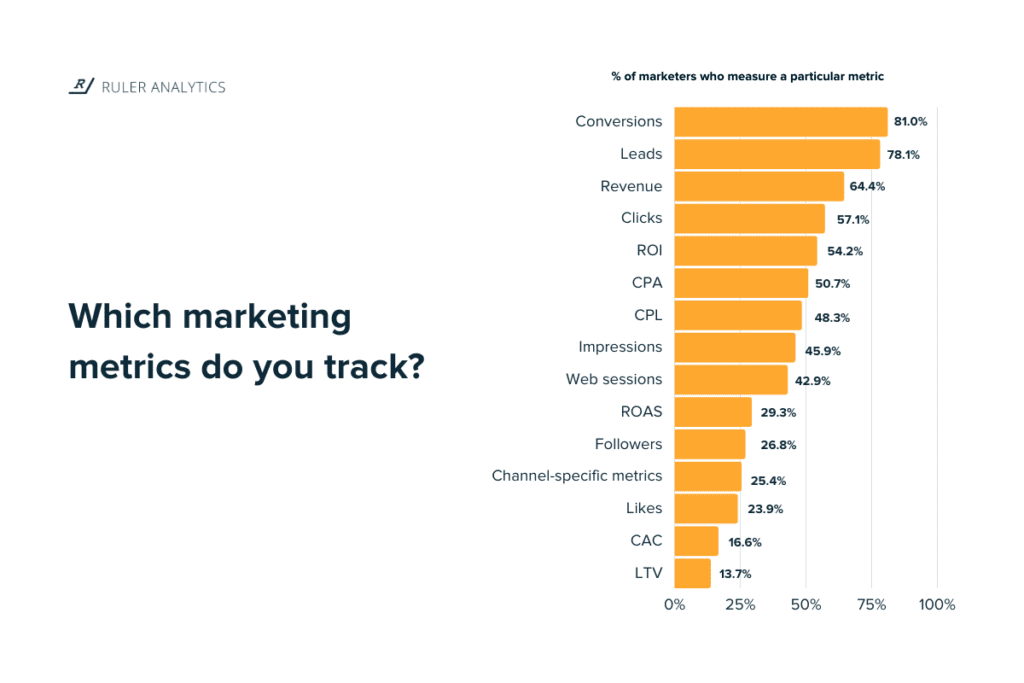
Some of these numbers might surprise you. But it’s likely due to the reporting tools that marketers have in place and a lack of confidence in the numbers they provide. With the right tools, you can ensure you have access to definitive, actionable metrics.
Every marketing professional has a wishlist. We asked marketers what would help them to improve their outputs. Here’s what they said:
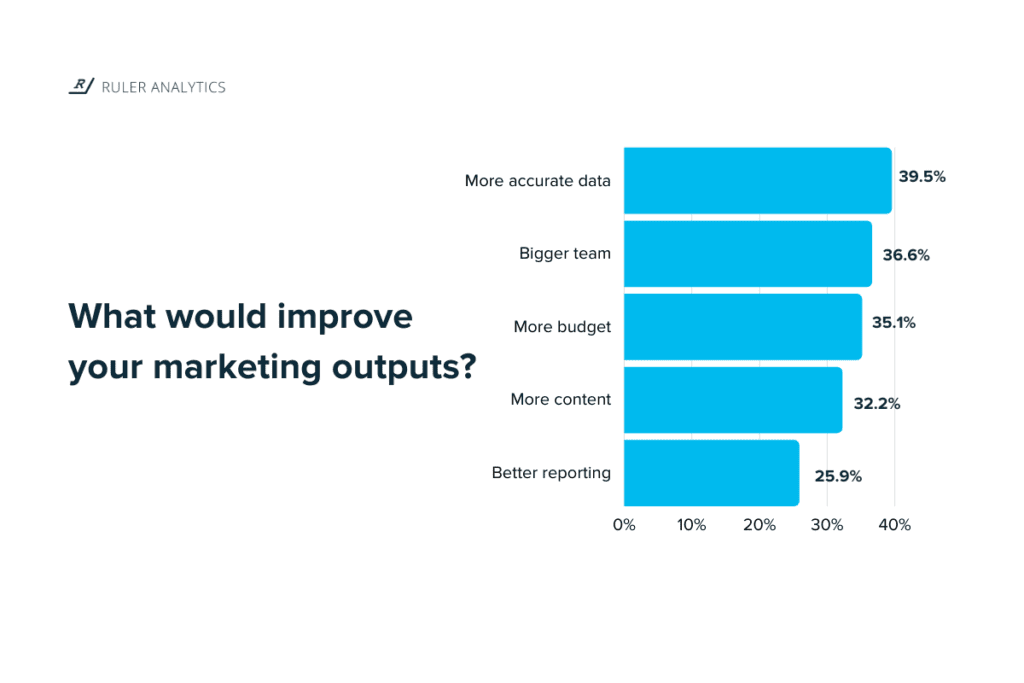
Accurate data is a great resource for marketers. With it, they can optimise their marketing and work to drive more valuable content.
More resource is always a plus. Whether that’s team, content, or budget. Especially when your team is working across a whole host of different channels and content types.
B2B marketers rely heavily on set channels like organic search and organic social so perhaps there’s a lack of willingness to experiment due to that lack of data.
Deciding which channels to prioritise as a marketer can be a tricky challenge to overcome. You need to decide which ones are going to drive the most traffic. But not only that, which are going to convert the most leads that go onto close.
Sounds like a lot of responsibility? That’s because it is! Luckily, tools exist that can help you optimise your marketing based on what already works.
We asked marketers exactly which channels they use. Here they are:
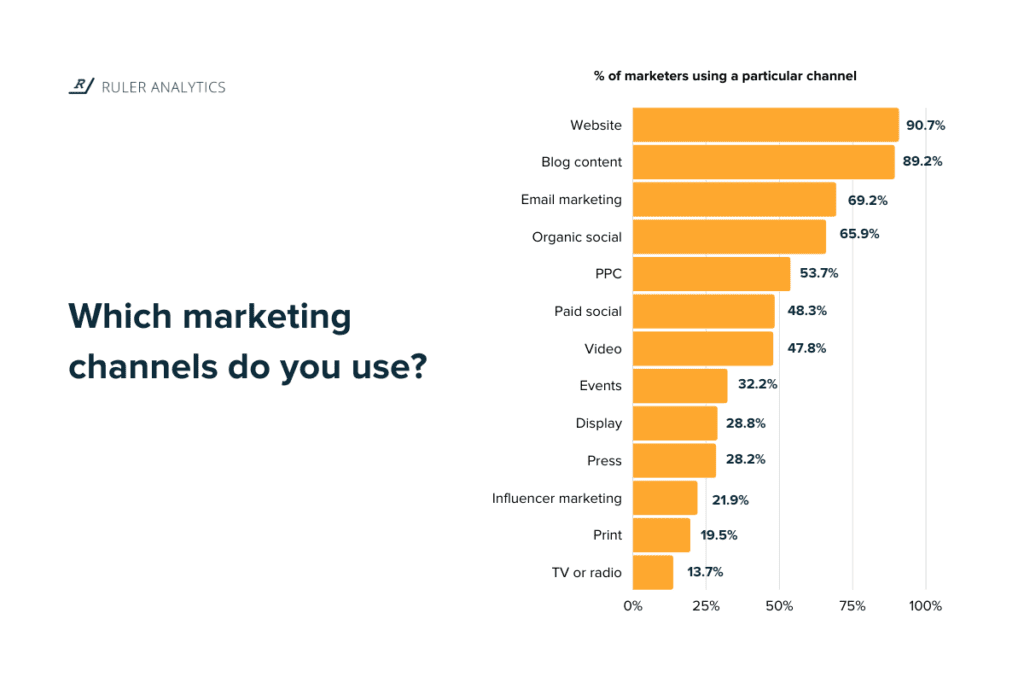
And there you have it, over 90 B2B marketing statistics that will hopefully help you better understand where you need to take your marketing.
Want to learn more about key marketing solutions? Subscribe to our newsletter to get insights delivered straight to your inbox.